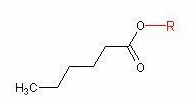| A set of molecules can be finite or virtually infinite. In the latter case we often speak of a molecule or compound class, which has an uncountable number of members, but within which only a limited number of members are of interest for most practical purposes. A very common class type is a homologous series, which is defined by a root or parent member and in which following class members are formally generated by successively inserting a bivalent group such as a methylen group between an already present methylen group and another group. | |||
| Chemists often sketch such sets or classes by simply drawing one member in a generic manner, using the symbols R, X, and Y (and others) in the same way they use element symbols. The following structure contains symbol R, representing an arbitrary alky group, to define the set of alky n-hexanoates. The corresponding CurlySMILES encoding uses the annotation {+R} to formally substitute the H-atom of the carboxylic acid group: | |||
|
|||
| The CurlySMILES annotation format provides various methods to encode a set of molecules in a more specific or limiting manner. For example, the annotation entry n=2-10 limits the above set to those molecules that contain alkyl groups with a C-atom count that is greater or equal to two and lower or equal to ten: | |||
|
|||
| This set can further be constrained by excluding branched alkyl groups: | |||
|
|||
Tweet
_
__
__
 __
__
__ ___ 
|
References
| [1] | A. Drefahl: CurlySMILES: a chemical language to customize and annotate encodings of molecular and nanodevice structures. J. Cheminf. 2011, 3:1; doi: 10.1186/1758-2946-3-1. |

Custom Search
|
